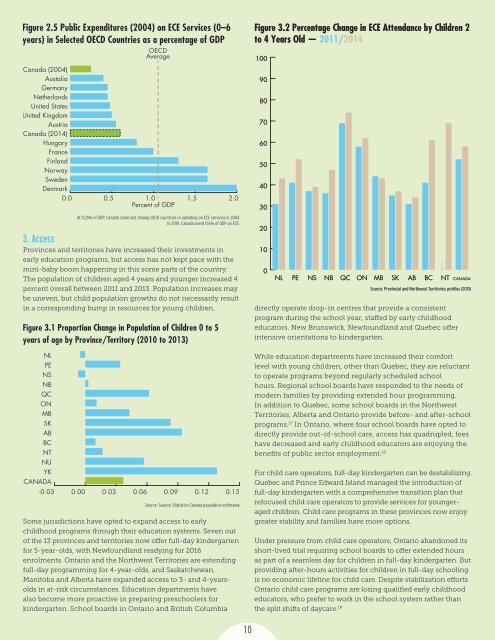early-childhood-education-report2014-eng
early-childhood-education-report2014-eng
early-childhood-education-report2014-eng
Create successful ePaper yourself
Turn your PDF publications into a flip-book with our unique Google optimized e-Paper software.
Figure 2.5 Public Expenditures (2004) on ECE Services (0–6<br />
years) in Selected OECD Countries as a percentage of GDP<br />
OECD<br />
Average<br />
Canada (2004)<br />
Austalia<br />
Germany<br />
Netherlands<br />
United States<br />
United Kingdom<br />
Austria<br />
Canada (2014)<br />
Hungary<br />
France<br />
Finland<br />
Norway<br />
Sweden<br />
Denmark<br />
0.0 0.5 1.0 1.5 2.0<br />
Percent of GDP<br />
At 0.25% of GDP, Canada came last among OECD countries in spending on ECE services in 2004.<br />
In 2014, Canada spent 0.6% of GDP on ECE.<br />
3. Access<br />
Provinces and territories have increased their investments in<br />
<strong>early</strong> <strong>education</strong> programs, but access has not kept pace with the<br />
mini-baby boom happening in this some parts of the country.<br />
The population of children aged 4 years and younger increased 4<br />
percent overall between 2011 and 2013. Population increases may<br />
be uneven, but child population growths do not necessarily result<br />
in a corresponding bump in resources for young children.<br />
Figure 3.1 Proportion Change in Population of Children 0 to 5<br />
years of age by Province/Territory (2010 to 2013)<br />
NL<br />
PE<br />
NS<br />
NB<br />
QC<br />
ON<br />
MB<br />
SK<br />
AB<br />
BC<br />
NT<br />
NU<br />
YK<br />
CANADA<br />
-0.03 0.00 0.03 0.06 0.09 0.12 0.15<br />
Source: Source: Statistics Canada population estimates.<br />
Some jurisdictions have opted to expand access to <strong>early</strong><br />
<strong>childhood</strong> programs through their <strong>education</strong> systems. Seven out<br />
of the 13 provinces and territories now offer full-day kindergarten<br />
for 5-year-olds, with Newfoundland readying for 2016<br />
enrolments. Ontario and the Northwest Territories are extending<br />
full-day programming for 4-year-olds, and Saskatchewan,<br />
Manitoba and Alberta have expanded access to 3- and 4-yearsolds<br />
in at-risk circumstances. Education departments have<br />
also become more proactive in preparing preschoolers for<br />
kindergarten. School boards in Ontario and British Columbia<br />
Figure 3.2 Percentage Change in ECE Attendance by Children 2<br />
to 4 Years Old — 2011/2014<br />
100<br />
90<br />
80<br />
70<br />
60<br />
50<br />
40<br />
30<br />
20<br />
10<br />
0<br />
NL<br />
PE<br />
NS<br />
NB<br />
QC<br />
ON<br />
Source: Provincial and Northwest Territories profiles (2013)<br />
directly operate drop-in centres that provide a consistent<br />
program during the school year, staffed by <strong>early</strong> <strong>childhood</strong><br />
educators. New Brunswick, Newfoundland and Quebec offer<br />
intensive orientations to kindergarten.<br />
CANADA<br />
While <strong>education</strong> departments have increased their comfort<br />
level with young children, other than Quebec, they are reluctant<br />
to operate programs beyond regularly scheduled school<br />
hours. Regional school boards have responded to the needs of<br />
modern families by providing extended hour programming.<br />
In addition to Quebec, some school boards in the Northwest<br />
Territories, Alberta and Ontario provide before- and after-school<br />
programs. 17 In Ontario, where four school boards have opted to<br />
directly provide out-of-school care, access has quadrupled, fees<br />
have decreased and <strong>early</strong> <strong>childhood</strong> educators are enjoying the<br />
benefits of public sector employment. 18<br />
For child care operators, full-day kindergarten can be destabilizing.<br />
Quebec and Prince Edward Island managed the introduction of<br />
full-day kindergarten with a comprehensive transition plan that<br />
refocused child care operators to provide services for youngeraged<br />
children. Child care programs in these provinces now enjoy<br />
greater stability and families have more options.<br />
Under pressure from child care operators, Ontario abandoned its<br />
short-lived trial requiring school boards to offer extended hours<br />
as part of a seamless day for children in full-day kindergarten. But<br />
providing after-hours activities for children in full-day schooling<br />
is no economic lifeline for child care. Despite stabilization efforts<br />
Ontario child care programs are losing qualified <strong>early</strong> <strong>childhood</strong><br />
educators, who prefer to work in the school system rather than<br />
the split shifts of daycare. 19<br />
MB<br />
SK<br />
AB<br />
BC<br />
NT<br />
10


